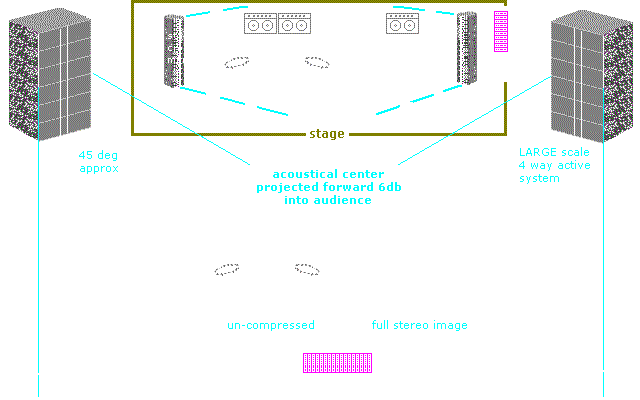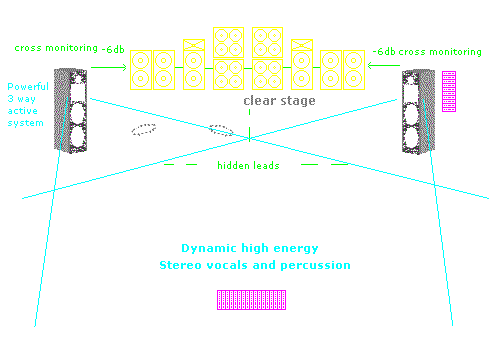For concert productions the musicians and artists should be autonomous on stage, in balance with each other first. Live production is exciting, because of the spontaneous and dynamic expression of the performance. Excessive sound amplification restricts natural expression and reduces audience enjoyment. An opera singer can perform without a sound system to an audience of thousands (in a good acoustical environment).
The speaker system should have focused directivity to the audience across the whole musical range, shifting the apparent acoustical centre forward by 6dB. The overall power level can also be amplified by 6dB for expression and detail. The combination of system directivity and increased power should give approx (+10dB) double loudness and presence, with full fidelity and realism. Wherever possible mixing should be from the centre in stereo, where sound from left and right intersects, and at a distance no further back than where the direct sound from the speakers becomes equal to the reflected reverberant energy of the room (critical distance).

Apparent acoustical center. The first objective is to shift the apparent acoustical center of the performance into the audience. The performance should acoustically appear to come from half the distance than it actually is. The performance should not appear to come from the left and right speaker stacks, but from a sound field that is projected into the audience by the speaker stacks. This may appear difficult but it can be achieved, except in excessive reverberant environment. Each separate left and right speaker stack must be capable of reproducing equally the full fidelity and dynamic power of the performance, without distortion or the use of compression limiting. This means that the acoustical gain of the sound system must be capable of unity with the performance.
Unity acoustical gain means that the sound system must be capable of reproducing the same dynamic sound energy (per unit area) as the stage performance (or greater). In theory each speaker stack should be capable of an unrestricted dynamic power response, enabling it to acoustically mirror the stage performance, one to one. Acoustical gain above unity is used for special effect, to make an instrument or voice appear to stand out from the performance. In extremely large venues where it is not possible for all the audience to be within reasonable proximity of the stage, then the added speaker systems should be identical, and positioned to minimise overlap.
Cross monitoring is the most effective means by which performers can hear themselves. The monitoring system should replicate as close as possible the main system, enabling the performers to hear themselves similarly with their audience. A wedge monitor should only be used where it is not possible for a performer to hear cross monitoring.
High-energy Stage production

The above drawing represents the alternate principal, of each instrument and voice being amplified and heard from, separate stage sound systems. If well done, the audience can experience startling dynamic clarity, as being up close or on stage with the musicians. This direction requires a high level of production skill, performed by professional musicians.
The stage instrument systems are independent as well as being interconnected, to act as cross-monitoring for each others instruments and vocals. The cross-monitoring into each instrument system is approx -6dB below what each instrument system is primarily used for. An example being that vocals can appear from the guitar and key-board systems, but at approx -6dB below the level that the instrument system is primarily used for.
This procedure gives an automatic bal lance for each musician to hear themselves, in proportion with the other instruments. The bass guitar and bass drum (kick) including other information below 100Hz from other instruments, is all reproduced through the dual bass instrument system.
The vocals and percussion are reproduced through the high powered 3 way active 'stereo system' on either side of the stage. The vocal-percussion speaker system does not need to produce sub-bass (below 60Hz). The vocal-percussion system can also be used for special effects. The system should be spaced as close as practical (left-right) to minimise time alignment difficulties in stereo imaging, and to avoid short percussive delays being heard by the musicians. Depending on the inward angling of the vocal-percussive system this can also provide cross-monitoring for the performers at the front of the stage.


